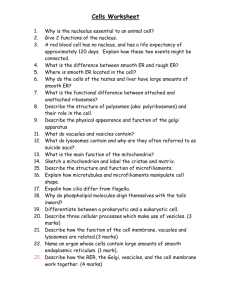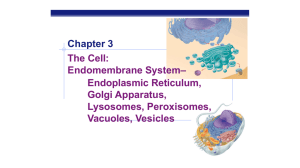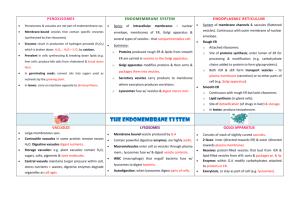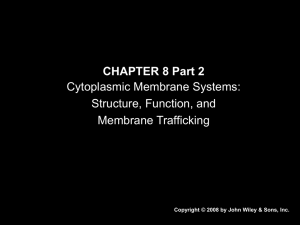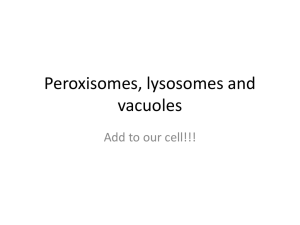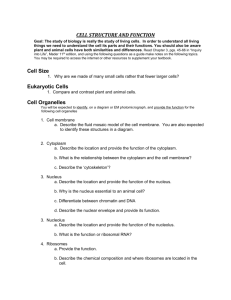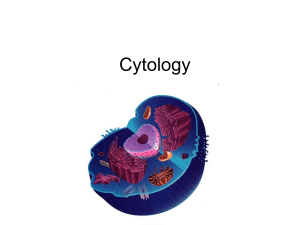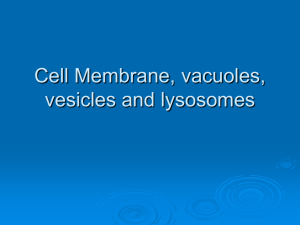2. The Golgi apparatus finishes, sorts, and ships cell products
advertisement
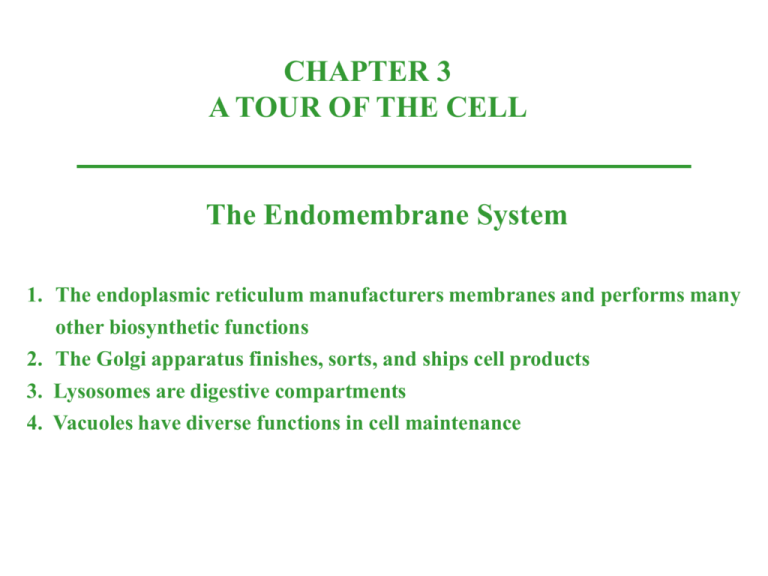
CHAPTER 3 A TOUR OF THE CELL The Endomembrane System 1. The endoplasmic reticulum manufacturers membranes and performs many other biosynthetic functions 2. The Golgi apparatus finishes, sorts, and ships cell products 3. Lysosomes are digestive compartments 4. Vacuoles have diverse functions in cell maintenance Introduction • Many of the internal membranes in a eukaryotic cell are part of the endomembrane system. • These membranes are either in direct contact or connected via transfer of vesicles, sacs of membrane. • In spite of these links, these membranes have diverse functions and structures. • In fact, the membranes are even modified during life. • The endomembrane system includes the nuclear envelope, endoplasmic reticulum, Golgi apparatus, lysosomes, vacuoles, and the plasma membrane. 1. The endoplasmic reticulum manufacturers membranes and performs many other biosynthetic functions • The endoplasmic reticulum (ER) accounts for half the membranes in a eukaryotic cell. • The ER includes membranous tubules and internal, fluid-filled spaces, the cisternae. • The ER membrane is continuous with the nuclear envelope and the cisternal space of the ER is continuous with the space between the two membranes of the nuclear envelope. • There are two, albeit connected, regions of ER that differ in structure and function. • Smooth ER looks smooth because it lacks ribosomes. • Rough ER looks rough because ribosomes (bound ribosomes) are attached to the outside, including the outside of the nuclear envelope. • The smooth ER is rich in enzymes and plays a role in a variety of metabolic processes. • Enzymes of smooth ER synthesize lipids, including oils, phospholipids, and steroids. • These includes the sex hormones of vertebrates and adrenal steroids. • The smooth ER also catalyzes a key step in the mobilization of glucose from stored glycogen in the liver. • An enzyme removes the phosphate group from glucose phosphate, a product of glycogen hydrolysis, permitting glucose to exit the cell. • Other enzymes in the smooth ER of the liver help detoxify drugs and poisons. • These include alcohol and barbiturates. • Frequent exposure leads to proliferation of smooth ER, increasing tolerance to the target and other drugs. • Muscle cells are rich in enzymes that pump calcium ions from the cytosol to the cisternae. • When nerve impulse stimulates a muscle cell, calcium rushes from the ER into the cytosol, triggering contraction. • These enzymes then pump the calcium back, readying the cell for the next stimulation. • Rough ER is especially abundant in those cells that secrete proteins. • As a polypeptide is synthesized by the ribosome, it is threaded into the cisternal space through a pore formed by a protein in the ER membrane. • Many of these polypeptides are glycoproteins, a polypeptide to which an oligosaccharide is attached. • These secretory proteins are packaged in transport vesicles that carry them to their next stage. • Rough ER is also a membrane factory. • Membrane bound proteins are synthesized directly into the membrane. • Enzymes in the rough ER also synthesize phospholipids from precursors in the cytosol. • As the ER membrane expands, parts can be transferred as transport vesicles to other components of the endomembrane system. 2. The Golgi apparatus finishes, sorts, and ships cell products • Many transport vesicles from the ER travel to the Golgi apparatus for modification of their contents. • The Golgi is a center of manufacturing, warehousing, sorting, and shipping. • The Golgi apparatus is especially extensive in cells specialized for secretion. • The Golgi apparatus consists of flattened membranous sacs - cisternae - looking like a sac of pita bread. • The membrane of each cisterna separates its internal space from the cytosol • One side of the Golgi, the cis side, receives material by fusing with vesicles, while the other side, the trans side, buds off vesicles that travel to other sites. • During their transit from the cis to trans pole, products from the ER are modified to reach their final state. • This includes modifications of the oligosaccharide portion of glycoproteins. • The Golgi can also manufacture its own macromolecules, including pectin and other noncellulose polysaccharides. • During processing material is moved from cisterna to cisterna, each with its own set of enzymes. • Finally, the Golgi tags, sorts, and packages materials into transport vesicles. 3. Lysosomes are digestive components • The lysosome is a membrane-bounded sac of hydrolytic enzymes that digests macromolecules. • Lysosomal enzymes can hydrolyze proteins, fats, polysaccharides, and nucleic acids. • These enzymes work best at pH 5. • Proteins in the lysosomal membrane pump hydrogen ions from the cytosol to the lumen of the lysosomes. • While rupturing one or a few lysosomes has little impact on a cell, but massive leakage from lysosomes can destroy an cell by autodigestion. • The lysosomes creates a space where the cell can digest macromolecules safely. • The lysosomal enzymes and membrane are synthesized by rough ER and then transferred to the Golgi. • At least some lysosomes bud from the trans face of the Golgi. • Lysosomes can fuse with food vacuoles, formed when a food item is brought into the cell by phagocytosis. • As the polymers are digested, their monomers pass out to the cytosol to become nutrients of the cell. • Lysosomes can also fuse with another organelle or part of the cytosol. • This recycling, this process of autophagy renews the cell. • The lysosomes play a critical role in the programmed destruction of cells in multicellular organisms. • This process allows reconstruction during the developmental process. • Several inherited diseases affect lysosomal metabolism. • These individuals lack a functioning version of a normal hydrolytic enzyme. • Lysosomes are engorged with indigestable substrates. • These diseases include Pompe’s disease in the liver and Tay-Sachs disease in the brain. 4. Vacuoles have diverse functions in cell maintenance • Vesicles and vacuoles (larger versions) are membrane-bound sacs with varied functions. • Food vacuoles, from phagocytosis, fuse with lysosomes. • Contractile vacuoles, found in freshwater protists, pump excess water out of the cell. • Central vacuoles are found in many mature plant cells. • The membrane surrounding the central vacuole, the tonoplast, is selective in its transport of solutes into the central vacuole. • The functions of the central vacuole include stockpiling proteins or inorganic ions, depositing metabolic byproducts, storing pigments, and storing defensive compounds against herbivores. • It also increases surface to volume ratio for the whole cell. • The endomembrane system plays a key role in the synthesis (and hydrolysis) of macromolecules in the cell. • The various components modify macromolecules for their various functions.
